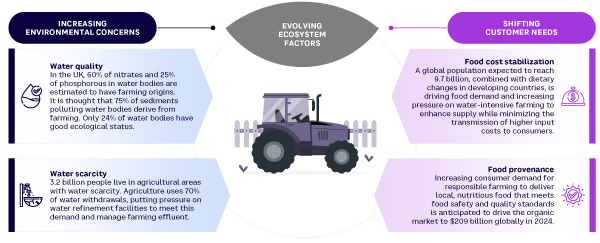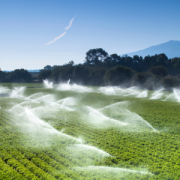AMPLIFY VOL. 37, NO. 7

New and effective farming practices are central to sustainably meeting the world’s future food needs. But environmental issues, combined with shifting consumer demands, make farming an uncertain, complex, and economically challenging endeavor and one that is highly individual to each farmer.1-3
This article summarizes joint thinking by Arthur D. Little (ADL) and the recently established UK Agri-Tech Centre on how best to address these challenges. It reflects our collaborative work on the potential of AI tools to help farmers and other stakeholders identify the best technologies to adopt.
Water quality and scarcity represent some of the biggest challenges affecting food production and food security. Agriculture accounts for about 70% of global water withdrawals, and demand is increasing due to rising temperatures, population growth, demand from other industries, and chronic resource mismanagement.4 The World Bank estimates that 25%-30% of all freshwater is wasted, costing the global economy US $14 billion annually.5
United Nations (UN) data indicates that to meet the world’s future food needs, food production will need to increase 70% by 2050.6 Irrigated land contributes 40% of global food production, yet some countries are already hitting the limits of their renewable water capacity.7 The Nile, the Colorado, the Ganges, and the Yellow Rivers are all at maximum capacity to support human and environmental demands.8
Farming is also a leading source of water pollution. The inappropriate use of fertilizers and pesticides is contaminating rivers and oceans, impacting public health and biodiversity.9
At the same time, consumers increasingly expect food to be not only sustainably and responsibly produced, but also inexpensive, not least through pressure from food processors and retailers.
Awareness of these issues has increased in recent years, and legislation and regulatory changes were introduced, but meeting these expectations through more efficient use of water and agricultural inputs is not free and can greatly reduce farmers’ profitability.10
Innovation Adoption Challenge
Change is needed (see Figure 1). Advancements in agricultural technologies (agri-tech) will be key to addressing the challenges faced by farmers and our world. Not surprisingly, agri-tech has been booming over the past decade, attracting significant investment from venture capitalists and outpacing investments in many other sectors.

Farmers, commodities suppliers, investors, and governments are well aware of the need for innovation to support more sustainable practices and protect scarce resources. However, due to the complexity and individuality of farming systems, knowing what tech to invest in and under what circumstances (not to mention how to realize benefits) is a significant challenge.
Each farm has unique geographies, landscapes, climates, soils, crops, and land-use histories.
There are multiple factors at play when considering how to maximize crop quality and yields and the many factors that will affect them going forward.11 When you add variables like climate change, regulations, geopolitics, financing, and rapid rates of technology innovation, decision makers find themselves facing an overwhelming amount of information that limits their ability to make optimal decisions for themselves, society, and the planet in terms of where to innovate and what to adopt.
This decision paralysis limits innovation investments, particularly in areas where technologies are rapidly evolving. (“Should I commit now to a solution that may become obsolete or delay the adoption decision in the expectation of future solutions being better value for my money?”)
Recent rapid advances in AI are producing tools that can help, starting with decisions about where to innovate and what to adopt. These tools can also provide information on the broader direction of relevant emerging technologies, informing adopt-now versus adopt-later decisions. Figure 2 shows how AI tools can support innovation decisions.

Use-Case Driven Technology Adoption
AI tools can undertake two key tasks for farmers and other food chain stakeholders: (1) understanding the trends, drivers, and uncertainties impacting innovation adoption and (2) identifying technologies related to specific use cases.
To do this, stakeholder needs are identified with an initial prompt (written input) to an AI tool, outlining desired benefits such as increased profits (see Figure 3). This can be followed by using AI tools and/or talking to expert growers to identify key ecosystem and adoption factors.

Ecosystem factors include elements that shape the broader context in which adoption occurs. Adoption factors refer to the specific attributes and conditions that affect the decision-making process of individuals or organizations about whether to adopt a new technology or innovation based on the use case. Both can either facilitate or hinder the integration of new technologies or practices. Examples of factors in each category are provided in Figure 4.

Expertise in creating a strong AI prompt is essential to accurately guide the tool to produce relevant data for subsequent integration with specific use cases and identify optimal technological solutions.
To demonstrate the utility of this approach, we present two case studies, one involving strawberry farmers in the UK and the other looking at considerations for oasis farmers in the Draa Valley in Morocco.
Case Study 1: Strawberry Farmers
UK strawberry growers pursuing greater profits need to identify solutions that enhance their business. A key area for enhancement is water management, in terms of access, use, and disposal. Strawberries have exacting moisture requirements that necessitate intense water use, usually delivered via irrigation.
Ecosystem Factors
Identification of suitable agri-tech is impacted by a wide range of ecosystem factors, including market factors, climate conditions, pesticide and fertilizer regulation, and water regulation.
Market factors, including current and anticipated demand and ongoing input costs such as water and labor, influence innovation identification. Strawberry demand is strong, with the market expected to grow at a compound annual growth rate of 5.74% from 2023 to 2028.12 Despite this, wholesale pricing remained flat between 2021 and 2022 while production costs rose 25% between 2020 and 2022.13 Ideally, agri-tech solutions will help farmers achieve desired crop yield while minimizing water use and labor costs.
Climate conditions are increasingly volatile and must be considered in any solution searches. Unpredictable periods of drought in the UK threaten water security, a critical consideration given the requirement for consistent and even crop moisture, equivalent to 2.5 L/m2 of water per week throughout the growing season. Identified solutions should aim to maximize water continuity, minimize use, and enhance security.
Pesticide and fertilizer regulations are managed by the UK Chemicals Regulation Division (CRD) of the Health and Safety Executive (HSE), which authorizes pesticide use and places limits on the maximum concentration that can remain in and on consumer crops. The pressure on growers to ensure that produce meets current regulations, alongside market demand to reduce inputs, has resulted in a strong driver for innovation to reduce chemical inputs (e.g., via integrated pest management). Anticipation of this should act as a filter on available innovations for compatibility with pesticide-reducing techniques.
With 40% of water pollution in England stemming from agriculture and rural land management, it is unsurprising that farmers are subject to several water-related regulations. English water regulations are drafted by the Department for Environment, Food & Rural Affairs (Defra) and enforced by the Environment Agency.14,15
Political pledges to address water-quality concerns through automatic fines of water companies and independent monitoring of outlets create a regulatory headwind that could eventually see monitoring requirements placed on farmers.16 In addition, irrigators are subject to licensing requirements that require evidence of efficient water use. Innovations should therefore facilitate compliance with existing and potential future regulations through efficient water use that minimizes the risk of polluting runoff.
Adoption Factors
Economic factors can constrain innovation adoption. For example, the ability of soft fruit farmers to adopt high-cost innovations will be limited by access to financing (debt versus equity-based), the terms of the farm holding (owner occupied, wholly tenanted, or mixed tenure), and the ability to forecast and afford ongoing costs. Thus, any technology solutions must be low-cost in both CAPEX and OPEX.
Technical literacy can impede strawberry cultivators’ adoption of agri-tech solutions. For example, after implementing a new irrigation system, growers must have extensive knowledge of irrigation methods (drop, soaker hose, micro-sprinklers, or overhead sprinklers), equipment (water abstraction, distribution, pumping, pump controls, and electrical controls), installation, and ongoing maintenance to create an optimal solution for their crop. Accessing relevant expertise externally presents a time and financial cost that most farmers can ill afford.
The regulatory environment, such as existing efficiency requirements for irrigators and government water management grants, can also impact affordability and thus implementation of suitable innovations. For example, Wicks Farm in East Sussex, a specialist strawberry grower, received UK £250,000 (about US $318,447) toward construction of a 32,000-cubic-meter reservoir to reduce water usage and serve as a local flood defense.17 Grants such as this, although beneficial for this single farmer and geography, are dependent on sufficient government finances that are under continuous pressure from competing calls for taxpayer money. This pressure creates a credible risk that government support will be reduced or withdrawn, threatening uptake of agricultural innovations by farmers dependent on this financial assistance.
Case Study 2: Oasis Farmers
Small and medium-sized oasis farmers in the Draa Valley face increasing challenges due to water scarcity, with Morocco ranking among the world’s most water-stressed countries. Large industrial farmers draw more water due to their access to advanced irrigation equipment subsidized through the Green Morocco Plan while oasis farmers struggle for access due to land fragmentation and challenges navigating the bureaucratic processes. Choosing the right technology to support oasis farmers is a complex exercise that requires consideration of both ecosystem factors and adoption constraints.
Ecosystem Factors
Climate conditions in the Draa Valley are hostile and uncertain, requiring smart, secure, predictive technologies. Droughts and aridity, coupled with a decrease in already-irregular rainfall (ranging from 50 to 2,000 mm/year), exacerbate water scarcity. The situation is further complicated by the low quality of available water maps. The main water source is the El Mansour Eddahbi dam, but its annual releases are no longer sufficient, and its storage capacity is expected to fall from 583 million cubic meters in 1991 to below 250 by 2050.18
Soil health and management presents another challenge. Almost a third of the soil has become arid, with degradation increasing downstream of the dam. Erosion and increasing salinity are two other serious concerns.
Water laws and regulations are limited, with no mechanism to control groundwater pumping in the region, even though Morocco launched policies to limit groundwater overdrawing in 2009 through the National Water Strategy and National Water Plan. Compartmentalization among government sectors has hindered the development of effective solutions for water-related issues like groundwater depletion. Grassroots organizations play a crucial role in governing groundwater, focusing on local control to protect “their” aquifer from overexploitation. These community-led efforts involve crafting and enforcing local rules to manage water resources sustainably, ensuring long-term availability for local needs.19
Adoption Factors
Economic challenges include the fact that a significant portion of oasis farmers rely mainly on informal financial services, as the Moroccan banking sector finances only 17% of the capital required for agriculture. The government has invested in water-intensive commodities, equipping large farms with drip irrigation, storage basins, or solar-powered well systems rather than supporting the date palm oasis. However, new projects driven by the International Fund for Agriculture Development (IFAD) are emerging that may promote access to appropriate and sustainable financial services.
Technology literacy is a considerable constraint for oasis farmers, characterized by incomplete databases, technological illiteracy, and insufficiently democratized solutions. Additionally, youth engagement in oasis farming is decreasing, leaving mainly aging men who are unfamiliar with digital tools. Initiatives are in place to increase technology literacy, including the Crossroads of Initiatives and Agroecological Practices center.
Logistical and economic security factors are another key constraint for oasis farmers. Recently, technologies like drip irrigation or water basins have been introduced but with a focus on industrial players. Oasis farmers rely on crumbling wells that become riskier when water is pursued at greater depths. Another disadvantage is the fragmented land, which presents challenges to drip irrigation and requires tailored technology for successful well design.
AI to the Rescue
The UK Agri-Tech Centre has been considering emerging opportunities for AI tools to support innovation adoption decisions. ADL has invested in two proprietary tools that can facilitate tailored identification of sustainable solutions to address specific agricultural use cases.
The first tool can determine and source data for the ecosystem factors from the numerous variables that might affect what technology to pick. The second tool can incorporate this data with specific use case and adoption variables to search for optimal technologies. These tools can help farmers sift through vast amounts of macro and microeconomic factors, regulations, and farm-specific challenges such as the ones highlighted in the two case studies.
UK Agri-Tech Centre’s research found that advances like using ultra-fine bubbles (UFBs) in irrigation can help minimize water and chemical use.20 UFBs possess unique properties such as high longevity and the ability to carry gases and surface adherents. A recent study found that UFBs improved strawberry crop yields while reducing potassium fertilizer requirements by 30% compared to levels using traditional drip irrigation.21 Without AI horizon-scanning and search tools, this innovation would likely have been overlooked by farmers relying on traditional identification approaches.
In Morocco, ancestral risk management methods, such as agricultural diversification through livestock, are insufficient to address the recurrence of droughts and heat waves.22 ADL’s toolset can help identify relevant innovative risk management instruments, underpinning so-called climate-smart agriculture practices. One example is Azud, a Moroccan company that makes drip irrigation systems designed to improve water efficiency while protecting against clogging and offering resistance to UV degradation, key considerations for Moroccan farmers.
Looking to the Future
Although AI tools can save stakeholders considerable time and money, expertise is required to craft effective prompts and use cases to interrogate the tools effectively. Nevertheless, with the rapid pace of innovation in AI, we envision a future where the two tools discussed here are combined into a single app-based interface with enhanced usability enabled by automatic geo-specific inputs such as climate, geopolitics, and regulations.
Such democratized access to information could equip farmers throughout the world to quickly gain visibility of suitable innovations to help them address specific challenges, enabling them to adopt technologies for profitable, sustainable farming.
The value proposition for agri-tech extends beyond farmers to investors, innovators, and regulators. Investors will benefit from knowledge of established and nascent technologies for investment (or to prepare for potential threats to existing investments). Innovators will benefit from visibility into key trends, uncertainties, and needs in farming alongside the current technology solutions to meet these, helping them identify “white spaces” to pursue. Regulators will benefit from an awareness of technologies that can facilitate their overarching goals and validate the feasibility of the regulations they enforce.
Acknowledgments
The authors would like to thank Alexander McCormack, Emma Chapelhow, and Katherine Wotherspoon for their assistance in preparing this article.
References
1 Holden, Joseph, et al. “Farming and Water 1: Agriculture’s Impacts on Water Quality.” The UK Water Partnership/Global Food Security, accessed July 2024.
2 “UN Calls for Urgent Action to Feed the World’s Growing Population Healthily, Equitably and Sustainably.” Press release, United Nations (UN), 19 April 2021.
3 “Global Organic Farming Market Growth 2024, Forecast to 2033.” The Business Research Company, 17 January 2024.
4 “UN World Water Development Report: Water for Prosperity and Peace.” UN Educational, Scientific and Cultural Organization (UNESCO), 26 February 2024.
5 Taft, Hessy L. “16 - Water Scarcity: Global Challenges for Agriculture.” Food, Energy, and Water: The Chemistry Connection, 2015.
6 “How to Feed the World in 2050.” Food and Agriculture Organization of the UN (FAO), accessed July 2024.
7 Rossi, Rachele. “Irrigation in EU Agriculture.” European Parliament, December 2019.
8 Michel, David. “Water and Food: How, When, and Why Water Imperils Global Food Security.” Center for Strategic & International Studies (CSIS), 16 October 2023.
9 Tongesayi, Tsanangurayi, and Sunungurai Tongesayi. “13 - Contaminated Irrigation Water and the Associated Public Health Risks.” Food, Energy, and Water: The Chemistry Connection, 2015.
10 Lumley, Liz. “Agriculture Is Fast Becoming a Growth Market for Fintech.” The Banker,
19 June 2024.
11 “Modern Agriculture Has Many Complex Challenges.” Syngenta Global, accessed
July 2024.
12 “United Kingdom Berries Market Size.” Mordor Intelligence, accessed July 2024.
13 “British Berry Growers — Written Evidence (HSI0054).” UK Parliament, 8 April 2023.
14 “Water and Sewerage Companies in England: Environmental Performance Report for 2020.” UK Environment Agency, 14 January 2022.
15 Department for Environment, Food & Rural Affairs, Environment Agency, and Steve Barclay. “Unlimited Penalties Introduced for Those Who Pollute Environment.” Gov.UK, 11 December 2023.
16 “Change: Labour Party Manifesto 2024.” UK Labour Party, accessed July 2024.
17 Wells, Izzie. “Water: How We’ve Helped Farmers Reduce Their Usage and Tackle Pollution.” Gov.UK, 3 May 2024.
18 Khebiza, Mohammed Yacoubi. “Environmental Vulnerability to Climate Change and Anthropogenic Impacts in Dryland (Pilot Study: Middle Draa Valley, South Morocco).” Journal of Earth Science & Climatic Change, January 2014.
19 Bossenbroek, Lisa, et al. “Watermelons in the Desert in Morocco: Struggles Around a Groundwater Commons-in-the-Making.” Water Alternatives, Vol. 16, No. 1, 2023.
20 “Exploring the Benefits of Ultra-Fine Bubbles in Agriculture.” Crop Health and Protection (CHAP), accessed July 2024.
21 Wang, Jian, et al., “Micro-Nano Bubble Water with Potassium Fertigation Improves Strawberry Yield and Quality by Changing Soil Bacterial Community.” Rhizosphere, Vol. 28, December 2023.
22 “Moroccan Farmers Search for Solutions in the Face of Climate Change.” World Bank Group, 20 December 2023.








